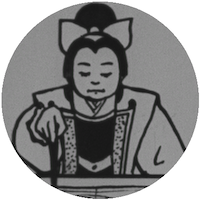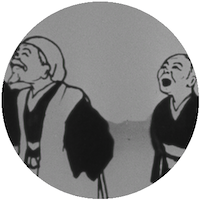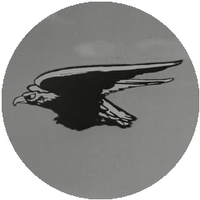Momotaro in the Sky
| Original Title | 漫画 空の桃太郎 |
|---|---|
| Japanese kana Rendering | Manga Sora no Momotaro |
| English Title | Momotaro in the Sky |
| Production Date | 1931 |
| Author | Yasuji Murata |
| Duration (minutes) | 13 |
| Sound | silent |
| Color | b/w |
| Plot | A penguin and an albatross from an island near the Antarctic complain to Momotaro about the damage done by a rogue eagle that emerged out of nowhere. Having heard their story, Momotaro promises that he will defeat the eagle. However, to fly to the island as far as 10,000 km from Japan, it is necessary to refuel twice on the way. The penguin explains that there are two fuel stations along the flight path. A pheasant and a monkey are working to prepare the airplane Momotaro. The pheasant tells the monkey that this is their first campaign since the Ogre war. Momotaro's grandparents give him a charm for protection as he sets off on the mission, accompanied by the dog, the monkey and the pheasant. A mortar also sees them off with a banzai. Looking down on Mt. Fuji, the Momotaro flies off to the Pacific Ocean. At the first fuel station, an albatross is waiting on a turtle, holding a gasoline can. Hanging from the airplane, the monkey catches the can. At the second fuel station, a penguin is waiting on a whale. While the penguin cheers up the hungry whale who sinks into the water, they are attacked by the rogue eagle. As the sinking whale floats back to the surface, the Momotaro emerges and the whale blows water up to send the three cans to the plane. On the island near the Antarctic, the rogue eagle is attacking seals. Spotting the eagle, the dog fires the machine gun from the Momotaro. After an aerial battle, the monkey uses a lasso to capture the eagle alive and the dog hits the eagle struggling in the water with a mallet. Hoisting a flag that reads "Japan's No. 1," the Momotaro returns home with the eagle hanging in the air. Penguins and albatrosses shout Banzai on the ground. |
| Description | Momotaro, a protagonist in a traditional Japanese story, appears in a contemporary story and sets off to the Antarctic instead of Onigashima Island to defeat a rogue eagle. Released at the time of the Manchurian Incident in 1931 and the Shanghai Incident in 1932, this film quickly gained popularity and Momotaro under the Sea, its sequel, was produced shortly afterward (1932). The airplane Momotaro bears resemblance to the Nakajima Army Type 91 fighter, which was officially adopted by the Japanese Army in this period. The story that the plane needs refueling twice to fly across the Pacific Ocean sounds quite realistic. Here is Murata's comment about this movie: The rogue eagle defeated by Momotaro also represents the United States, which was proud of its airplane technology at the time (Katsuei, May 1933). More specifically, Murata is likely to have had in mind the first successful flight across the Northern Pacific in 1931 by the American pilot Charles Lindbergh, who visited Japan on his way. According to a supplementary explanation to the Chronological List of Yasuji Murata's Films in the biography by Masao Okamoto entitled "Yasuji Murata and Animation Movies (Last)" (Movie and Television Technology, August 1992), a version with an accompaniment by the Japan Victor Orchestra was also produced in addition to the silent version. |
| Production Company | Yokohama Cinema Shokai* |
| Distribution | 35-mm version: Okamoto Yoko (Kanto)* and Oku Shokai (Kansai)* |
| Release Date | |
| Credits: Director | Animation: Yasuji Murata |
| Credits: Staff, Cast, etc. | Supervise: Chuzo Aochi |
| Intertitles | T1: Momotaro in the Sky T2: Supervised by Chuzo Aochi / Animation by Yasuji Murata T3: I understand your situation. We'll defeat the rogue eagle for you. T4: There's one problem. Your island is almost 10,000 km away. We'll have to refuel twice. T5: We thought of that. We have 2 fuel stations along the flight path. T6: Very well. We'll prepare for takeoff immediately. T7: Our first campaign since the Ogre war. T8: Can't wait to get at 'em! T9: Day of the mission T10: "1st fuel station" T11: Can you see them yet? T12: Banzai! T13: "2nd fuel station" T14: You're not supposed to sink! T15: But I'm so hungry. T16: Just hold on for a while. T17: Hold your fire. Capture it alive. T18: Banzai, Momotaro! T19: Momotaro in the Sky / The End |
| Censorship - Date and Number | Home Minister censorship number: F12399 (November 5, 1931) |
| References | ・ "Introduction to New Educational Movies: Momotaro in the Sky," Eiga Kyoiku, No. 45 (November 1931), p. 37 (with photos). ・ Kazue Yoshii, " Description of the March 1932 Movie for Schools: Momotaro in the Sky," Eiga Kyoiku, No. 49 (March 1932), p. 36. ・ Yasuji Murata, "Momotaro in the Sky, 1932 Educational Film Recommended by the Association of Movies for Schools (under the Supervision of Daimai)," Katsuei, No. 63 (May 1933), p. 31 (with photos). |
| Frames per Second | 20fps |
| Source of Digital Copy | The 35mm nitrate positive donated from Yokosuka city -> The 35mm internegative owned by NFC |
| Completeness | complete |
| Additional Notes | simple digital restoration The mark of "*" will provide an additional explanation gained from the bibliographical information. |
| Related Links |
Related categrory
Main characters
Please tell us what you think about this website by filling out a short questionnaire.
To educational users: Please provide us with feedback on website usage for educational purposes.
- Unauthorized copying and replication of the contents on this site are prohibited.






